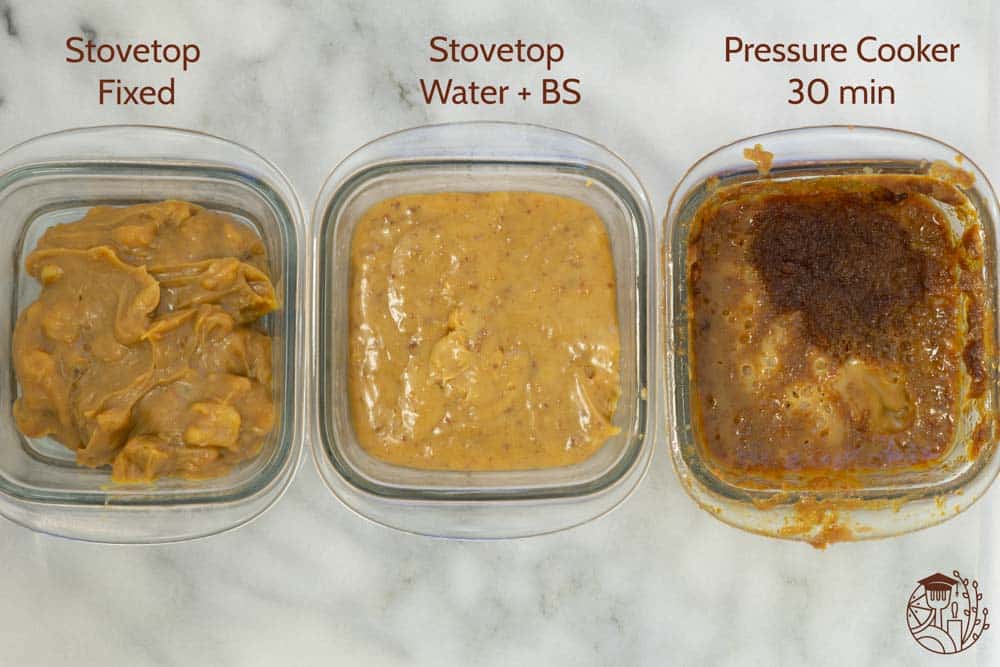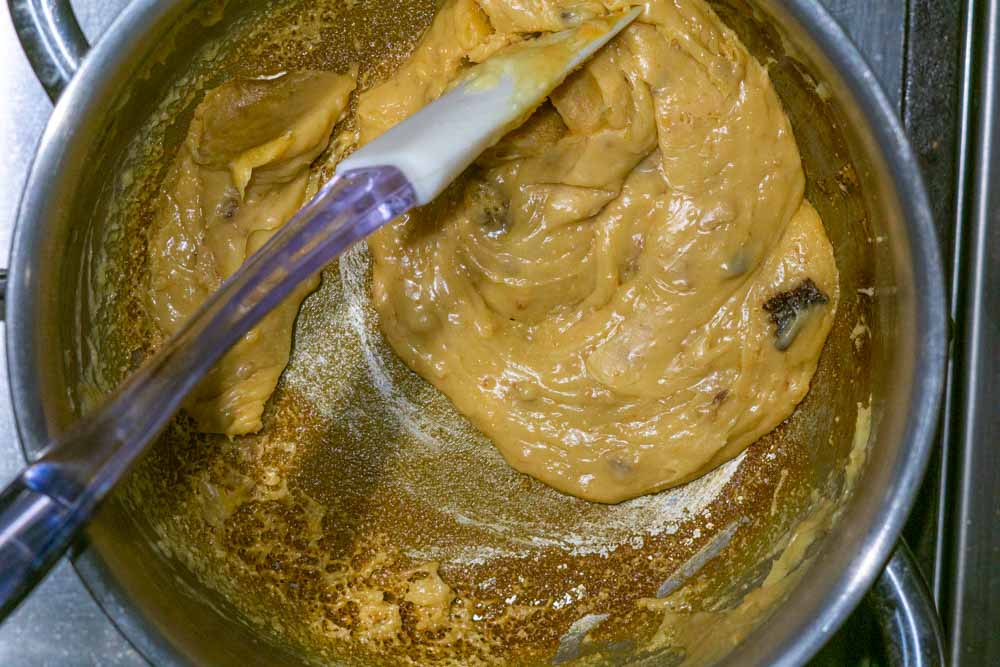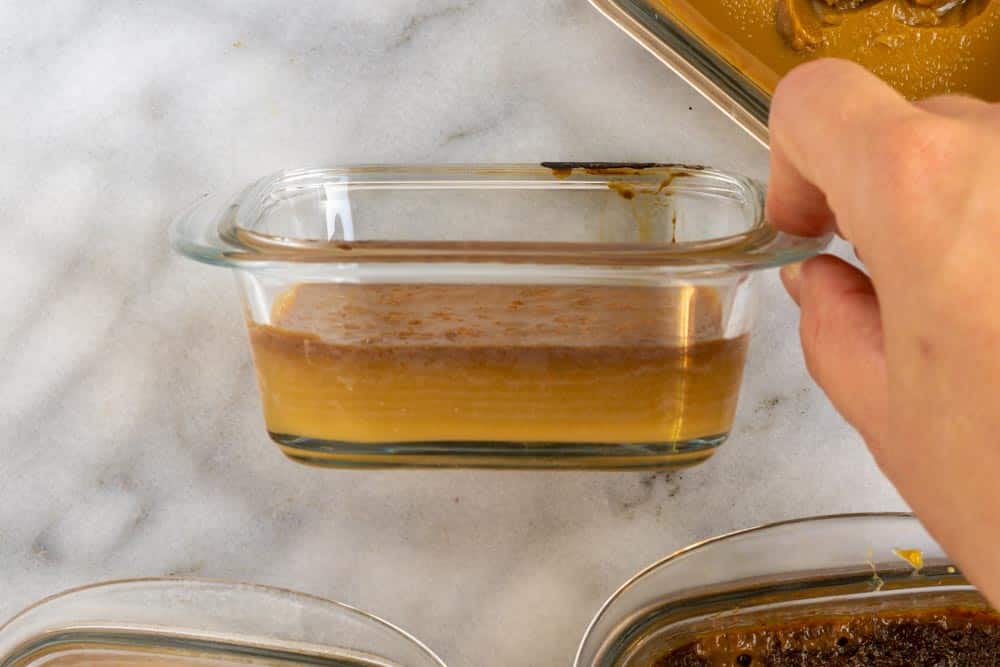Learn the science behind:

Making Dulce de Leche – Oven vs Pressure Cooker
This rich, creamy, sweet, brown, milky sweet is downright delicious. Dulce de leche is immensely popular in Latin America and there exist a lot of ways to make it. We experimented with several methods: using a pressure cooker, oven, and the stovetop. Aiming to understand the science behind making this milky treat.
Dulce de leche is the result of a fascinating transformation. Liquid white milk and sugar transform into a thick, brown, almost paste-like consistency. A range of chemical processes plays a role in this transformation, the most important one being the Maillard reaction. It causes the drastic color and flavor changes.
How brown, thick, and caramelly the final dulce de leche becomes doesn’t just depend on the starting ingredients. We found that the preparation method also has a big impact on your dulce de leche.
What is dulce de leche?
Dulce de leche is a thick, brown sweet made by cooking down milk and sugar. It has a sweet, very rich, complex dairy-like flavor. It’s quite thick and doesn’t flow freely.
Dulce de leche is the Argentinian and Uruguayan name for this sweet. However, it is popular all throughout Latin America. In Chile it’s called ‘manjar’, in Colombia ‘arequipe’ and ‘cajeta’ in Mexico. In English some may refer to it as milk caramel.
Many versions exist
There exist a lot of varieties of dulce de leche, which are all just a little different. Some have a darker brown color, others are a little thicker, or sweeter.
Depending on how the dulce de leche was made, it can become very firm. Some dulce de leche types can be cut into blocks. Others are considerably thinner and flow out of a pack or can be squeezed out of a bottle. Which type you make or buy, depends on what you’ll be using it for.
How to make dulce de leche
Traditionally, dulce de leche is made by heating milk and sugar (sucrose) until a thick, brown consistency is achieved. Some baking soda may be added as well.
Making dulce de leche this way is time-consuming. To prevent the milk from boiling over or sticking to the bottom of the pan, someone needs to be next to the pan all the time. This is especially true at the end of the cooking process.
Why does dulce de leche boil over?
Milk boils over and easily sticks to the pan due to the proteins in the milk. They are good at holding onto gases. During cooking water in the milk evaporates. The evaporated water gets trapped by the proteins. The gas pushes the milk up.


A (long) success: milk + sugar
Making sweetened condensed milk on the stovetop using milk, sugar, and a little baking soda worked well. As long as you stir regularly – and continuously towards the end – it turns a nice even brown color.
By continuously stirring the mixture you also influence the consistency of the dulce de leche. You prevent a firm gel from forming during cooking. The stirring motion will continuously break this up. As a result, we found stovetop make dulce de leche more liquid-like than some of the other methods.
What happens when making dulce de leche?
When transforming milk + sugar into dulce de leche, a few key transformations happen:
- It turns brown
- The mixture thickens
Let’s have a look at why this happens so we can steer the process in the right direction.
Why dulce de leche browns – Maillard reaction
First up: browning.
When milk and sugar are mixed and heated, a very common chemical reaction takes place: the Maillard reaction. This is a complex series of chemical reactions that starts with proteins and sugars reacting. Milk supplies the proteins, and both milk and sugar (sucrose) supply the required sugars.
The result of this ‘chemical party’ is a beautiful brown color, as well as the formation of a lot of flavors and aromas.
Even though the Maillard reaction can take place at low temperatures, it proceeds considerably faster at higher temperatures. Also, it happens faster when the water content is reduced slightly. It’s why you probably see most of the browning happen towards the end!
Baking soda gives a little push
The speed of the Maillard reaction also depends on the pH-value of the environment. A pH-value below 7 indicates an acidic environment, whereas >7 is considered alkaline. The Maillard reaction proceeds faster in an alkaline environment. Most browning happens at a pH-value between 9-10.
It’s why baking soda may be added to the milk and sugar. Baking soda is alkaline and increases the pH of the milk + sugar mix. As a result, more browning takes place.
Why dulce de leche thickens
Finished dulce de leche is a lot thicker than the initial sugar + milk mix. In some cases, it even forms a thick gel-like consistency. Just how thick depends on the process parameters that were used when making the dulce de leche. The thickening is due to two processes that happened simultaneously.

Moisture evaporates
First of all, moisture evaporated during cooking. As a result, the % of water in dulce de leche is significantly lower than it is in the initial starting materials. Manufacturers aim for a concentration of 70w% solids. In other words, only 30% of the dulce de leche is made of water.
If you’d zoom in on dulce de leche, you’d find a high concentration of sugars, alongside fats and proteins.
These fats, proteins, and sugars can no longer move around freely, they need water to move around in. However, most of that water is gone, or has been bound to other molecules, held in place.
Proteins stabilize
Dulce de leche is mostly made up of sugars, proteins, and fats and left-over water. Sugars dissolve in water, but unfortunately, fats and water don’t mix well. Fat tends to split from the water phase.
It’s where the proteins come in. They help ensure the fats don’t separate. In binding both the water and fat particles, it forces them to ‘stay together’.
The heat also causes the proteins to unravel and form structures within the dulce de leche. It adds to the thickening of the dulce de leche!
How you make dulce de leche impacts the structure of the final dulce de leche. If you continue stirring until the end, you continue to break up structures that proteins might forms. However, if you don’t stir at all, the proteins get a better chance at forming these 3D networks.
Prevent curdling – Baking soda to the rescue (again)
Whereas you do want dulce de leche to thicken, you do not want it to curdle!
If you’ve made cheese before, you know that milk curdles in the presence of acids. To prevent this from happening, you can add the opposite of an acid: an alkaline ingredient. Again, baking soda comes in handy!
Cooking milk with acids makes cheese, such as paneer.
Evaluating ways to make dulce de leche
Recall that the ‘traditional’ way to make dulce de leche involves cooking milk & sugar for long periods of time? Whereas this makes a great dulce de leche. It’s not always the most efficient and easiest way to do so.
In industry, automated cookers are used. Vacuum may be used to help evaporate moisture. Also, the incoming milk may be concentrated before starting the cooking process, all to make the process more efficient.
On a smaller, kitchen scale, you also have options to simplify and streamline the dulce de leche making process. We’ll investigate a couple:
- Using sweetened condensed milk
- Using a pressure cooker
- Using the oven
Taking a short-cut: Sweetened condensed milk (SCM)
Since evaporating water takes a lot of time when making dulce de leche, skipping this step can make the process a lot faster. It’s where sweetened condensed milk (SCM) can help.

SCM: a shelf stable, concentrated version of milk
Milk is not very stable. Unrefrigerated, it spoils in a matter of hours, especially in warm climates. As such, shelf-stable versions of milk have been investigated for centuries (think cheese!).
In the 19th century, another shelf-stable version of milk was developed: sweetened condensed milk (SCM). To make SCM, milk is first concentrated by evaporating water. Next, additional sugar (sucrose) is added.
Don’t confuse sweetened condensed milk (SCM) with evaporated milk. SCM contains additional sugar whereas evaporated milk, also called unsweetened condensed milk, does not contain extra sugar.
The low moisture and high sugar content make sweetened condensed milk stable for long periods of time. Most microorganisms can no longer grow due to the low water activity of about 0,83. The few yeasts and molds that can still grow under these condition can be kept out by proper packaging.
The perfect starting point for dulce de leche
Remember that dulce de leche is made from milk & sugar? You can replace both with just sweetened condensed milk.
SCM is the perfect starting point for making dulce de leche. Since a lot of water has already been evaporated, all you need to do is make it turn brown!
The ratio of milk & sugars are set in sweetened condensed milk. That does limit your creative freedoms. You can’t add more or less sugar to the milk, whereas you can do so when using just milk & sugar.
Don’t use sweetened condensed milk on the stovetop

However, if you use sweetened condensed milk (SCM) as your starting material, you will also have to change you process. This is actually quite common in food manufacturing, the recipe and process are closely related!
Because of its high sugar and milk content, SCM browns very quickly. Because it contains so little moisture it is hard to stir. Since the stovetop only heats from the bottom, this makes it very hard to prevent burning and ensure even heating throughout.
Slight success: thinned sweetened condensed milk
To overcome these challenges, you can add little water as well as baking soda to the SCM. The water makes it easier to stir. The baking soda speeds up the browning reactions.

It’s better, but not ideal.
Ideally, we’re looking for a process that can:
- Evenly heat the SCM (thus no need for stirring)
- Without burning it
If you leave a can of sweetened condensed milk for several years, it will slowly start to turn (light) brown. This is the same process that happens when making dulce de leche: the Maillard reaction. It just happens a lot slower at room temperature.
Oven – a hands off method
Using an oven is actually a great way to transform sweetened condensed milk (SCM) into dulce de leche.
To ensure even heating you want to make sure the outside of the dulce de leche can’t become much hotter than the inside. You can use a water bath to do so. The temperature of the water bath will never raise above 100°C (212°F). By placing the SCM in the water bath, you prevent it from overheating.
It’s important that the moisture from the water bath can’t evaporate! It’s why it’s crucial to cover the water bath, for example with aluminum foil.

The oven can then be set at a temperature well above 100°C (212°F). The oven’s job is simply to keep the water hot. We tested a temperature of 220°C (428°F) which worked well.
It takes a while – 2 hours
Cooking the sweetened condensed milk in the oven does take a long time, we tested 2 hours. However, you don’t have to do any stirring, you just need to wait!
Pressure cooker – Just walk away
To speed things up even more, you can use (our favorite) method for making dulce de leche from sweetened condensed milk: a pressure cooker (we used an InstantPot).
A pressure cooker is great at creating even heating. Because of the high pressure, you can cook at temperatures above the regular boiling point of water (100°C, 212°F). Hot steam fills the pressure cooker and as a result, it is a lot better at heat transfer than an oven.
You can pressure cook sweetened condensed milk into dulce de leche in a mere 30 minutes. This gives a dark brown, delicious dulce de leche.
The dulce de leche is quite thick, almost gel-like, just like the oven-made dulce de leche. The proteins haven’t been disrupted by stirring, and have been able to form these sturdy networks.

Baking soda has a big (positive) impact!
Notice that adding baking soda had great a significant impact on the dulce de leche. Adding baking soda resulted in:
- A slightly browner dulce de leche, it tasted a bit more caramel-like.
- Thinner dulce de leche. The baking soda had prevented the formation of that thick gel. Whereas it still didn’t flow, it definitely was easier to scoop. The higher pH-value likely interferred with the protein network formation.

Dulce de leche: science + technology
Our final favorite method for making dulce de leche in a kitchen uses the pressure cooker. It’s a simple, almost foolproof method that takes optimal advantage of available technological advances!

Pressure Cooker Dulce de Leche
This dulce de leche recipe is made in a pressure cooker, making it a very hands-off method. Your exact cooking times may differ slightly depending on the tray you use!
Ingredients
- 1 can of sweetened condensed milk (400g)
- 1/4 tsp baking soda.
Instructions
- Open the can of sweetened condensed milk and pour into a heat proof bowl.
- Mix the baking soda throughout.
- Cover the bowl with aluminum foil.

- Take your pressure cooker and prep it for steaming under pressure (preparation may differ per pressure cooker). We placed a rack in the cooker and poured water until just below the rack. We then placed the bowl on top of this rack.
- Pressure cook under high pressure for 30 minutes*.
- Release the pressure and take the bowl from the cooker**. Take care, it will be hot!
Notes
*The ideal cooking time will depend on your preferred consistency and color, as well as on the bowl you use:
- Cooking for longer gives a thicker and browner dulce de leche.
- Using a bowl with a smaller diameter will require a longer cooking time. It takes longer for the center to heat.
**The dulce de leche will continue cooking for some time if you don't take it out of the pressure cooker. You can also decrease the cooking time under pressure and leave it in for a little longer afterwards.
References
Rodríguez Analía, Lema Patricia, Bessio María Inés, Moyna Guillermo, Olivaro Cristina, Ferreira Fernando, Panizzolo Luis Alberto, Characterization of Melanoidins and Color Development in Dulce de Leche, a Confectionary Dairy Product With High Sucrose Content: Evaluation of pH Effect, an Essential Manufacturing Process Parameter, Frontiers in Nutrition, 2021, DOI: 10.3389/fnut.2021.753476
Kristberg Kristbergsson, Jorge Oliveira, Traditional Foods: General and Consumer Aspects, Spriner, 2016, chapter 9, link
Oliveira, M. N., Penna, A. L. B., Nevarez, H. Garcia, Production of Evaporated Milk, Sweetened Condensed Milk and ‘Dulce de Leche’, 2009, pp. 149-179, https://doi.org/10.1002/9781444322729.ch4
Maricel E. Presilla, Garn Cocina Latina – The food of Latin America, 2012, W.W. Norton and Company, p. 809-810
Rodrigo Stephani, Júlia Francisquini, Ítalo Tuler Perrone, Antônio Fernandes de Carvalho and Luiz Fernando Cappa de Oliveira (February 9th 2019). Dulce de Leche—Chemistry and Processing Technology, Milk Production, Processing and Marketing, Khalid Javed, IntechOpen, DOI: 10.5772/intechopen.82677. Available from: https://www.intechopen.com/chapters/65575
What's your challenge?
Struggling with your food product or production process? Not sure where to start and what to do? Or are you struggling to find and maintain the right expertise and knowledge in your food business?
That's where I might be able to help. Fill out a quick form to request a 30 minute discovery call so we can discuss your challenges. By the end, you'll know if, and how I might be able to help.




